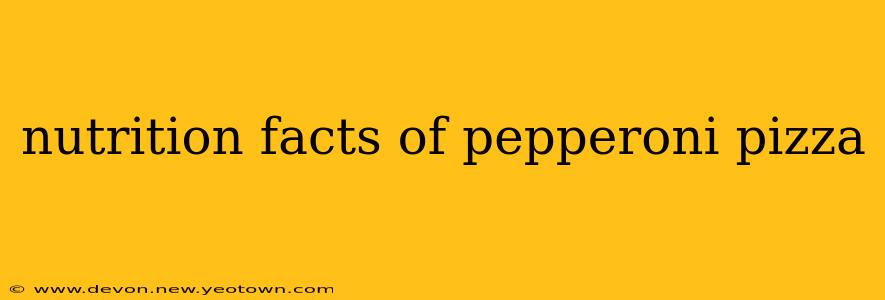Pepperoni pizza. Just the words conjure up images of warm, cheesy goodness, a comforting classic enjoyed by millions. But beyond the deliciousness, lies a nutritional landscape that's worth exploring. This isn't just about calories; it's about understanding what you're eating and making informed choices. Let's slice into the details.
What are the typical nutritional values of a pepperoni pizza?
This is tricky! The nutritional information for pepperoni pizza varies wildly depending on the size of the pizza, the type of crust (thin crust, deep dish, stuffed crust – oh my!), the amount of pepperoni, the type of cheese used, and the specific recipe of the restaurant or brand. A single slice from a large pizza will have drastically different nutritional content compared to a personal-sized pizza.
However, we can provide a general estimate. A typical slice (approximately 1/8th of a large 14-inch pizza) might contain around:
- Calories: 250-350
- Fat: 10-15g
- Saturated Fat: 5-8g
- Cholesterol: 20-30mg
- Sodium: 400-600mg
- Carbohydrates: 30-40g
- Fiber: 2-4g
- Sugar: 2-5g
- Protein: 10-15g
It's crucial to remember these are estimations. Always check the nutrition facts provided by the specific restaurant or pizzeria where you're purchasing your pizza. Many chains now provide nutritional information online or on their packaging.
How many calories are in a slice of pepperoni pizza?
As mentioned above, the calorie count varies dramatically. A thin-crust slice might clock in around 250 calories, while a deep-dish slice loaded with extra cheese and pepperoni could easily surpass 400 calories. Think of it this way: every extra topping, every extra ounce of cheese, adds to the calorie count.
Is pepperoni pizza healthy?
Let's be honest: pepperoni pizza is not typically considered a health food. The high levels of saturated fat, sodium, and processed ingredients mean it shouldn't be a staple in a healthy diet. However, that doesn't mean you can never enjoy it. Moderation is key. Occasionally indulging in a slice or two won't derail your health goals, especially if you're generally eating a balanced diet.
What are the ingredients in pepperoni pizza?
The main ingredients are a wheat flour based crust, tomato sauce (typically containing tomatoes, herbs, and spices), mozzarella cheese, and pepperoni (cured pork sausage). Additional ingredients might include other cheeses, vegetables, or meats depending on the specific pizza. The ingredients list can often vary depending on the brand or restaurant. Pay close attention to the ingredients list if you have allergies or dietary restrictions.
How much sodium is in pepperoni pizza?
Sodium content is a significant concern in many processed foods, and pepperoni pizza is no exception. High sodium intake can contribute to high blood pressure and other health problems. A single slice can contain anywhere from 400-600mg of sodium, a substantial portion of the recommended daily intake.
What are the benefits of eating pepperoni pizza?
While not a health powerhouse, pepperoni pizza does offer some small benefits. It provides some protein from the cheese and pepperoni, and some carbohydrates for energy. However, these benefits are easily outweighed by the negative nutritional aspects if consumed frequently or in large quantities.
In conclusion, understanding the nutritional facts of pepperoni pizza is crucial for making informed food choices. While it can be a delicious treat, remember to practice moderation and check the nutritional information provided by your pizza source for the most accurate details. Enjoy your pizza responsibly!

